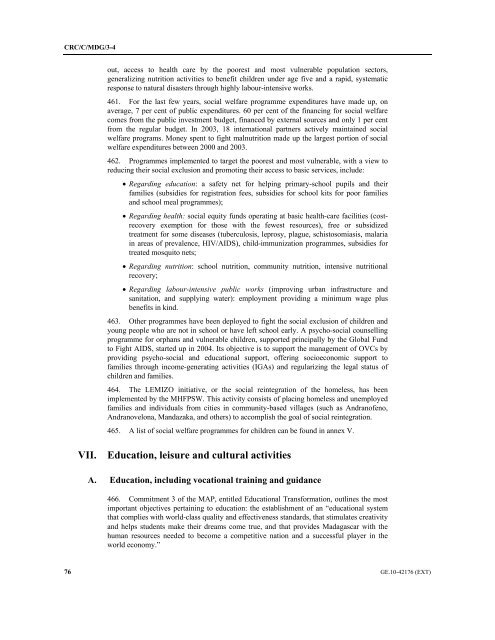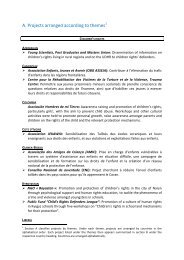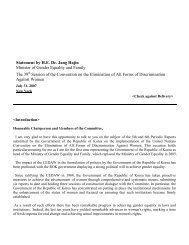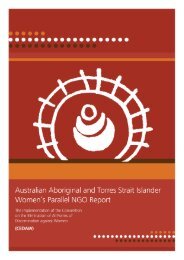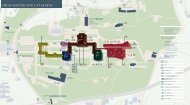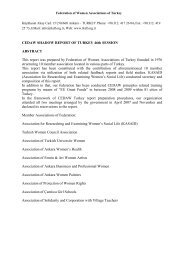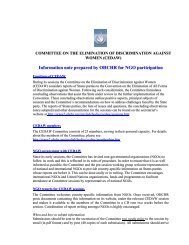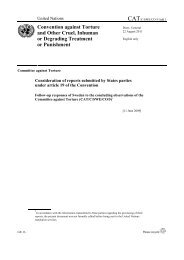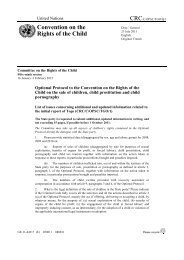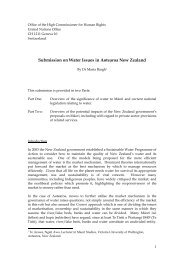CRC/C/MDG/3-4 - Office of the High Commissioner for Human Rights
CRC/C/MDG/3-4 - Office of the High Commissioner for Human Rights
CRC/C/MDG/3-4 - Office of the High Commissioner for Human Rights
You also want an ePaper? Increase the reach of your titles
YUMPU automatically turns print PDFs into web optimized ePapers that Google loves.
<strong>CRC</strong>/C/<strong>MDG</strong>/3-4<br />
out, access to health care by <strong>the</strong> poorest and most vulnerable population sectors,<br />
generalizing nutrition activities to benefit children under age five and a rapid, systematic<br />
response to natural disasters through highly labour-intensive works.<br />
461. For <strong>the</strong> last few years, social welfare programme expenditures have made up, on<br />
average, 7 per cent <strong>of</strong> public expenditures. 60 per cent <strong>of</strong> <strong>the</strong> financing <strong>for</strong> social welfare<br />
comes from <strong>the</strong> public investment budget, financed by external sources and only 1 per cent<br />
from <strong>the</strong> regular budget. In 2003, 18 international partners actively maintained social<br />
welfare programs. Money spent to fight malnutrition made up <strong>the</strong> largest portion <strong>of</strong> social<br />
welfare expenditures between 2000 and 2003.<br />
462. Programmes implemented to target <strong>the</strong> poorest and most vulnerable, with a view to<br />
reducing <strong>the</strong>ir social exclusion and promoting <strong>the</strong>ir access to basic services, include:<br />
• Regarding education: a safety net <strong>for</strong> helping primary-school pupils and <strong>the</strong>ir<br />
families (subsidies <strong>for</strong> registration fees, subsidies <strong>for</strong> school kits <strong>for</strong> poor families<br />
and school meal programmes);<br />
• Regarding health: social equity funds operating at basic health-care facilities (costrecovery<br />
exemption <strong>for</strong> those with <strong>the</strong> fewest resources), free or subsidized<br />
treatment <strong>for</strong> some diseases (tuberculosis, leprosy, plague, schistosomiasis, malaria<br />
in areas <strong>of</strong> prevalence, HIV/AIDS), child-immunization programmes, subsidies <strong>for</strong><br />
treated mosquito nets;<br />
• Regarding nutrition: school nutrition, community nutrition, intensive nutritional<br />
recovery;<br />
• Regarding labour-intensive public works (improving urban infrastructure and<br />
sanitation, and supplying water): employment providing a minimum wage plus<br />
benefits in kind.<br />
463. O<strong>the</strong>r programmes have been deployed to fight <strong>the</strong> social exclusion <strong>of</strong> children and<br />
young people who are not in school or have left school early. A psycho-social counselling<br />
programme <strong>for</strong> orphans and vulnerable children, supported principally by <strong>the</strong> Global Fund<br />
to Fight AIDS, started up in 2004. Its objective is to support <strong>the</strong> management <strong>of</strong> OVCs by<br />
providing psycho-social and educational support, <strong>of</strong>fering socioeconomic support to<br />
families through income-generating activities (IGAs) and regularizing <strong>the</strong> legal status <strong>of</strong><br />
children and families.<br />
464. The LEMIZO initiative, or <strong>the</strong> social reintegration <strong>of</strong> <strong>the</strong> homeless, has been<br />
implemented by <strong>the</strong> MHFPSW. This activity consists <strong>of</strong> placing homeless and unemployed<br />
families and individuals from cities in community-based villages (such as Andran<strong>of</strong>eno,<br />
Andranovelona, Mandazaka, and o<strong>the</strong>rs) to accomplish <strong>the</strong> goal <strong>of</strong> social reintegration.<br />
465. A list <strong>of</strong> social welfare programmes <strong>for</strong> children can be found in annex V.<br />
VII. Education, leisure and cultural activities<br />
A. Education, including vocational training and guidance<br />
466. Commitment 3 <strong>of</strong> <strong>the</strong> MAP, entitled Educational Trans<strong>for</strong>mation, outlines <strong>the</strong> most<br />
important objectives pertaining to education: <strong>the</strong> establishment <strong>of</strong> an “educational system<br />
that complies with world‐class quality and effectiveness standards, that stimulates creativity<br />
and helps students make <strong>the</strong>ir dreams come true, and that provides Madagascar with <strong>the</strong><br />
human resources needed to become a competitive nation and a successful player in <strong>the</strong><br />
world economy.”<br />
76 GE.10-42176 (EXT)


